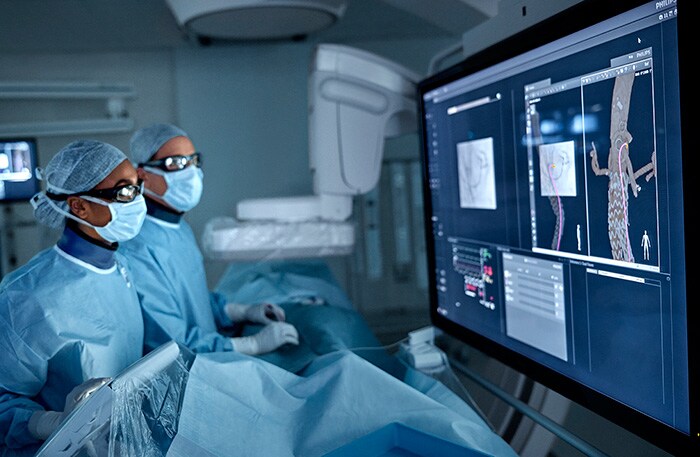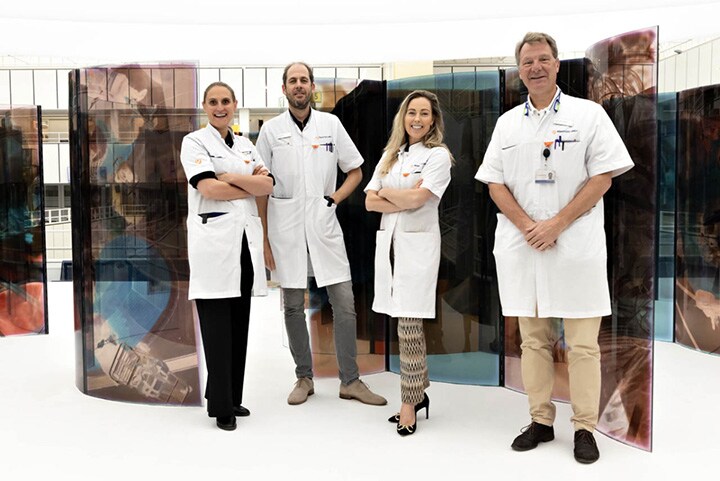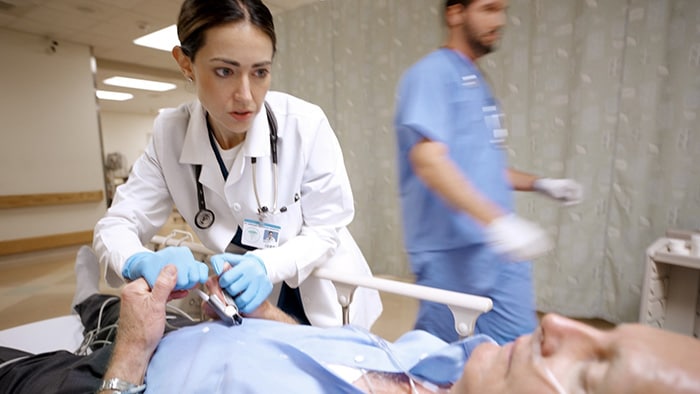Op maandag 23 oktober voerden dr. Barend Mees en prof. Geert-Willem Schurink de eerste operatie uit met de Philips LumiGuide. De chirurgen voerden een complexe behandeling uit om een aorta te repareren (ook wel BEVAR genoemd). LumiGuide maakt het mogelijk om licht te gebruiken om de katheters en voerdraden in het lichaam in 3D weer te geven tijdens een minimaal invasieve procedure. Normaalgesproken wordt röntgenstraling gebruikt voor visualisatie van katheters en andere medische hulpmiddelen in het lichaam tijdens minimaal invasieve procedures. Deze nieuwe oplossing maakt gebruik van de FORS technologie die door Philips samen met o.a. UMC Utrecht en MUMC+ is ontwikkeld.

"Als koploper op het gebied van beeldgestuurde therapie is het ons doel om nieuwe baanbrekende technologieën te ontwikkelen waarmee artsen patiënten efficiënter en effectiever kunnen behandelen”, zegt Bert van Meurs, Chief Business Leader van Image Guided Therapy en Precision Diagnosis bij Philips. “De afgelopen jaren hebben we daarom intensief met verschillende partners samengewerkt, waaronder het MUMC+, om deze oplossing die mogelijk wordt gemaakt door FORS-technologie, verder te ontwikkelen en continu te verbeteren. We gaan ons de komende tijd volop inzetten om meer artsen en patiënten wereldwijd van LumiGuide te kunnen laten profiteren."
Het MUMC+ publiceerde het volgende artikel over de eerste operatie.
In de vaatchirurgie wordt veel gebruik gemaakt van kijkoperaties met voerdraden en katheters, bijvoorbeeld via de liesslagader. Dit wordt ook wel een endovasculaire ingreep genoemd. De vaatchirurg brengt de katheter en voerdraad in en ‘navigeert’ op basis van röntgenbeelden naar de plaats in de vaten waar de behandeling nodig is, bijvoorbeeld het plaatsen van een stent om een verwijding van de aorta te verstevigen en zo scheuren te voorkomen.
Navigatie met röntgen
Voor deze navigatie wordt doorgaans gebruik gemaakt van röntgenstraling, die zorgt voor 2D-beelden in grijstinten van de vaten van de patiënt. Dit helpt de chirurg, maar kent ook nadelen: een beeld in 2D helpt niet goed als de katheter en voerdraad naar voren en naar achteren moeten (diepte beweging – in plaats van de link/rechts beweging), omdat die beweging simpelweg niet in beeld gebracht kan worden. Het gebruik van röntgenstraling zelf moet ook beperkt worden, omdat röntgenstraling potentieel schadelijk is. Voor een patiënt, voor wie dit meestal eenmalig is, is het schadelijke effect minimaal. Zorgmedewerkers daarentegen komen ondanks beschermingsmiddelen meer in aanraking met de straling. Daarom is het belangrijk om nieuwe technieken te onderzoeken en te ontwikkelen om het gebruik van röntgenstraling te verminderen.
LumiGuide met FORS technologie
In de afgelopen jaren heeft Philips in nauwe samenwerking met vaatchirurgen van onder meer het MUMC+ en UMC Utrecht een nieuwe technologie ontwikkeld: Fiber Optic RealShape (FORS). Deze technologie maakt gebruik van licht dat door ingebouwde glasvezels door een voerdraad wordt gestuurd. Het gebruik van LumiGuide gecombineerd met beeldvormingsapparatuur levert real-time 3D beelden in heldere, contrasterende kleuren, waardoor de vaatchirurg de mogelijkheid krijgt deze katheters en voerdraden vanuit alle mogelijke hoeken te bekijken. In 2019 bleek uit onderzoek onder leiding van het UMC Utrecht dat deze technologie veilig en bruikbaar is. Onlangs heeft Philips, LumiGuide op de markt gebracht, waar deze FORS technologie in is geïntegreerd.
Wereldprimeur in Maastricht UMC+
Belangrijkste potentiële voordelen zijn de vermindering van röntgenstraling –veiliger voor patiënt én behandelaars – en snellere operaties, waarbij de kans op complicaties en hersteltijd mogelijk worden verminderd. De afgelopen jaren is deze techniek verder ontwikkeld, bijvoorbeeld met een verbeterde gebruiksvriendelijkheid voor de vaatchirurg, de mogelijkheid om alle compatibele endovasculaire katheters te gebruiken en automatische registratie van de voerdraad en katheter met behulp van kunstmatige intelligentie. Vaatchirurgen dr. Barend Mees en prof. Geert Willem Schurink voerden deze week een kijkoperatie via de lies uit, waarbij ze de wereldprimeur hadden door voor een deel van de ingreep gebruik te maken van LumiGuide met FORS technologie. Schurink is enthousiast over deze stap vooruit. ’In het Hart+Vaat Centrum van het MUMC+ willen we blijven innoveren, zodat we onze patiënten beter kunnen helpen en ook zelf minder blootgesteld worden aan röntgenstraling. Daarom zijn we trots dat we nauw samenwerken met Philips om deze innovatie mogelijk te maken en verder te ontwikkelen.’

Vascular surgeons from MUMC+ are the first to use Philips LumiGuide powered by FORS-technology
On Monday 23 October dr. Barend Mees and professor Geert-Willem Schurink performed the first procedure with Philips LumiGuide. The surgeons helped a patient with a complex aortic repair (BEVAR). LumiGuide uses light to visualize the surgical devices in 3D during an endovascular procedure. Normally surgeons use X-ray to visualize their devices during the procedure. The new LumiGuide solution uses FORS technology which had been developed by Philips with academic partners including UMC Utrecht and MUMC+.
"As a leader in image-guided therapy, our goal is to develop new breakthrough technologies that enable physicians to treat patients more efficiently and effectively," said Bert van Meurs, Chief Business Leader of Image Guided Therapy and Precision Diagnosis at Philips. "In recent years, we closely collaborated with various partners, including MUMC+, to further develop and continuously improve this solution powered by FORS technology. Our aim is to enable more physicians and patients worldwide to benefit from LumiGuide in the future."
MUMC+ published the below article about the first procedure.

Vascular surgery is performed minimally invasively with devices such as guidewires and catheters, for example in the aorta. This is also called endovascular surgery. The vascular surgeon introduces the catheter and guidewire within the blood vessels and ‘navigates’ these devices, based on X-ray images, to the location where treatment is needed, such as where a stent needs to be placed to strengthen a dilated aorta to prevent rupture.
Navigation with X-ray
This navigation usually involves the use of X-ray, which provides grayscale 2D images of the patient's anatomy. This helps the surgeon to navigate within the body, but X-ray does have some disadvantages: it is difficult to navigate based on a 2D image, especially when the catheter and guidewire are moving within a 3D-space (right and left but also up and down). The use of X-ray should also be limited as it can potentially be harmful. For a patient, treatment is usually a one-time event and radiation is therefore limited. However, for the OR-staff who perform these procedures regularly, a high dose of radiation can have negative side effects – that is why the staff wears protective equipment. To reduce exposure to X-ray it is important to develop new technologies to reduce its use.
LumiGuide powered by FORS
In recent years, Philips has developed a new technology called Fiber Optic RealShape (FORS) in close collaboration with vascular surgeons from MUMC+, UMC Utrecht and other partners globally. This technology uses light travelling through a hair-thin optical fiber which is integrated within the guidewire. This enables the catheters and guidewires to be visualized live, in full shape and in color during the whole procedure. The surgeon can also view these devices from all possible angles within the anatomy. Combined with imaging equipment, this provides real-time 3D guidance in bright, contrasting colors. In 2019, research led by UMC Utrecht showed that this technology is safe and feasible. Philips recently launched LumiGuide, an integrated solution that is powered by FORS technology.
First global procedure in Maastricht UMC+
The most prominent potential benefits of this new solution are X-ray reduction - benefitting both patient and staff - and fast(er) procedures, which may in turn reduce both the potential risk of complications and overall recovery time. In the last couple of years, this technology has been further developed, for example with improved user-friendliness for vascular surgeons, the system now allowing all compatible catheters to be used, and with artificial intelligence now enabling automatic registration of the guidewire. Vascular surgeons Dr. Barend Mees and Prof. Geert Willem Schurink performed the surgery through the groin this week. They were the first in the world to use LumiGuide for part of the procedure. Schurink is delighted with this step forward. 'In the Heart+Vascular Center of the MUMC+, we want to continuously innovate so that we can improve patient care and reduce our own exposure to X-ray. That is why we are proud to be working closely with Philips to make this innovation possible and to further work on improving it.'

Deel op social media
Onderwerpen
Contact

Pieter de Meer
External Relations Lead Philips Benelux
Tel.: +31 6 25 26 90 65
You are about to visit a Philips global content page
Continue
Joost Maltha
Philips Global Press Office Tel: +31 6 10 55 8116
You are about to visit a Philips global content page
Continue












